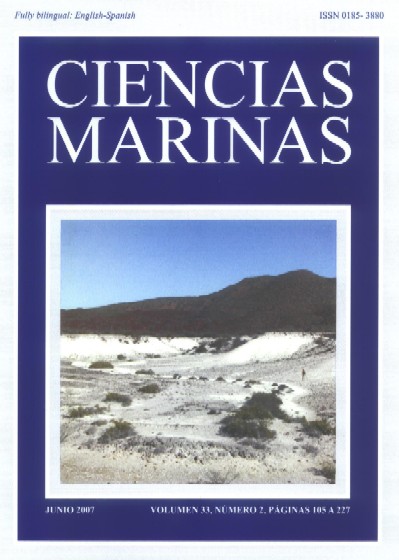Polychlorinated dibenzo-p-dioxins and dibenzofurans in fish from four different regions of Mexico
Main Article Content
Abstract
Las dibenzo-p-dioxinas policloradas y los dibenzofuranos policlorados (PCDDs/Fs), conocidos comúnmente como dioxinas, han sido reconocidos como contaminantes ambientales ubicuos. De entre todos los congéneres, los 2,3,7,8-sustituidos, los compuestos más tóxicos, fueron medidos en tejido de peces (Caranx caninus, Caranx hippos y Chirostoma estor estor) de tres regiones marinas y una laguna dulceacuícola de México. Las muestras estuvieron disponibles a nivel comercial y se adquirieron entre septiembre y diciembre de 2005 en Ensenada (Océano Pacífico), El Barril (Golfo de California), Ciudad del Carmen (Golfo de México) y el Lago de Pátzcuaro (centro del país). Las muestras de peces fueron analizadas usando cromatografía de gases/espectrometría de masas de alta resolución. Las concentraciones medias del total de PCDDs/Fs variaron de 0.3 a 1.6 pg g|00E2|??1 de peso húmedo en el siguiente orden: Pátzcuaro > Ciudad del Carmen > El Barril > Ensenada. Se encontró un perfil de congéneres particular para cada región estudiada, pero los congéneres OCDD y OCDF fueron relativamente importantes en todos los sitios de muestreo. En base al peso húmedo, las concentraciones totales de PCDDs/Fs y sus equivalentes tóxicos, encontradas en este estudio, fueron más bajas o estuvieron en el mismo intervalo que las de otros sitios alrededor del mundo, pero en base al contenido de lípidos, los equivalentes tóxicos de los peces de Pátzcuaro fueron mayores que algunos sitios. La ingesta de dioxinas fue calculada considerando porciones de filete de 200 g usando nuestros resultados, y ninguno de los peces muestreados en este estudio alcanzó la ingesta diaria tolerable establecida por la Organización Mundial de la Salud. Hasta donde tenemos conocimiento, éste es el primer reporte sobre niveles de PCDDs/Fs en peces de México.
Polychlorinated dibenzo-p-dioxins and polychlorinated dibenzofurans (PCDDs/Fs), known commonly as dioxins, have been recognized as ubiquitous environmental contaminants. Among those, the 2,3,7,8-substituted congeners, the most toxic compounds, were measured in fish tissue (Caranx caninus, Caranx hippos and Chirostoma estor estor) from three marine regions and one freshwater lagoon in Mexico. Samples were commercially available and were acquired between September and December 2005 in Ensenada (Pacific Ocean), El Barril (Gulf of California), Carmen City (Gulf of Mexico) and Patzcuaro Lake (central Mexico). The fish samples were analyzed using gas chromatography/high resolution mass spectrometry. Mean concentrations of total PCDDs/Fs ranged from 0.3 to 1.6 pg g|00E2|??1 wet weight and were in the following order: Patzcuaro > Carmen City > El Barril > Ensenada. A particular congener profile was found for every studied region, but OCDD and OCDF were relatively important congeners at all the sites. On a wet weight basis, the total concentrations of PCDDs/Fs and their toxic equivalents (TEQs) found in this study were lower or in the same range as those for other sites around the world, but on a lipid weight basis, TEQs from the Patzcuaro samples were higher than some other sites. Dioxin intake was calculated considering fillet portions of 200 g using our results, and none of the fish sampled in this study reached the tolerable daily intake established by the World Health Organization. To our knowledge, this is the first report to document PCDD/F levels in fish from Mexico.
Polychlorinated dibenzo-p-dioxins and polychlorinated dibenzofurans (PCDDs/Fs), known commonly as dioxins, have been recognized as ubiquitous environmental contaminants. Among those, the 2,3,7,8-substituted congeners, the most toxic compounds, were measured in fish tissue (Caranx caninus, Caranx hippos and Chirostoma estor estor) from three marine regions and one freshwater lagoon in Mexico. Samples were commercially available and were acquired between September and December 2005 in Ensenada (Pacific Ocean), El Barril (Gulf of California), Carmen City (Gulf of Mexico) and Patzcuaro Lake (central Mexico). The fish samples were analyzed using gas chromatography/high resolution mass spectrometry. Mean concentrations of total PCDDs/Fs ranged from 0.3 to 1.6 pg g|00E2|??1 wet weight and were in the following order: Patzcuaro > Carmen City > El Barril > Ensenada. A particular congener profile was found for every studied region, but OCDD and OCDF were relatively important congeners at all the sites. On a wet weight basis, the total concentrations of PCDDs/Fs and their toxic equivalents (TEQs) found in this study were lower or in the same range as those for other sites around the world, but on a lipid weight basis, TEQs from the Patzcuaro samples were higher than some other sites. Dioxin intake was calculated considering fillet portions of 200 g using our results, and none of the fish sampled in this study reached the tolerable daily intake established by the World Health Organization. To our knowledge, this is the first report to document PCDD/F levels in fish from Mexico.
Downloads
Download data is not yet available.
Article Details
How to Cite
Canedo-Lopez, Y., & Macias-Zamora, J. V. (2007). Polychlorinated dibenzo-p-dioxins and dibenzofurans in fish from four different regions of Mexico. Ciencias Marinas, 33(2), 217–227. https://doi.org/10.7773/cm.v33i2.1180
Issue
Section
Research note
This is an open access article distributed under a Creative Commons Attribution 4.0 License, which allows you to share and adapt the work, as long as you give appropriate credit to the original author(s) and the source, provide a link to the Creative Commons license, and indicate if changes were made. Figures, tables and other elements in the article are included in the article’s CC BY 4.0 license, unless otherwise indicated. The journal title is protected by copyrights and not subject to this license. Full license deed can be viewed here.

